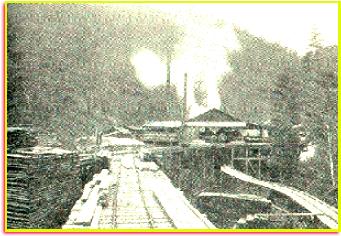With the arrival of the C&O Railroad, the boom years came to the Greenbrier Valley. These boom years lasted roughly from the Eighteen-hundreds to the Nineteen-Twenties. In addition to the large companies, of which the Saint Lawrence Boom and Lumber Company was the largest, small portable steam sawmills popped up here and there and such places as Caldwell became beehives of activity. However, none of these shipping places approached the amount of lumber that was shipped from Ronceverte. Prior to the building Greenbrier Division by the C&O, which ran from Wickham between Ronceverte and Caldwell to Durbin in Pocahontas County, huge amounts of logs were floated down the Greenbrier to the Saint Lawrence Boom and Lumber Company's boom at Caldwell. After the completion of the Greenbrier Division, the boom spread all the way to Durbin with mills of various types and towns coming into existance all up and down the river. Other industries,such as the foundry at Caldwell and the woolens mill at Second Creek, shipped their wares by the C&O.
click here for:Brown's Mill
A few years ago, I wrote a story about these times that won the Beckley Newspapers "Golden Pen Award." Here is the Story.

YESTERDAY
By Okey L. King
Yesterday, I lay aside my chores and treated myself to a rare weekday afternoon holiday. I dawned my newest workshirt, my best bib-overalls, and my Sunday straw hat and walked to Caldwell hoping to spend a pleasant afternoon.
When I had reached the bottom of our hill and crossed the still fairly new railroad tracks, I was greeted by a scene that was bustling with activity. The area around the Caldwell Depot was awash with people and vehicles of varied descriptions.

Scattered among the four-horse drays loaded with pungent smelling fresh sawn lumber from the small steam-powered sawmills that had sprung up in the surrounding area with the coming of the railroad, there was a handful of surreys and buggies occupied by some of the genteel folks who were waiting for the east-bound express. As I strolled closer, I recognized one of the young ladies of the Caldwell Family, who lived at he Elmhurst Mansion, and her aunt. Under the stern supervision of the aunt, the girl was chatting excitedly with a young gentleman who had a derby cocked jauntly on his head. I heard her say something about, "...going to Richmond to buy new gowns for my coming out!"
In contrast to the fashionable folks and the drivers of the buggies, the teamsters from the drays and the laborers that were loading the lumber on the cars on the siding were rough and tumble. Some had smelly cigars clamped in their mounth as they went about their toil. The air was thick with curses, laughter, and loud talk.
As I turned to walk on toward the little hamlet of Caldwell, I heard a thounderous roar. Belching ash and black smoke, a locomotive emerged from Howard's Tunnel trailed by a dowen flatcars loaded with timber for the St. Lawrence Boom and Lumber Company at Ronceverte. Suddenly I heard a curse, and I jumped out of the way just in time to avoid being crushed by a dray loaded with woolens from the Grange's woolen mills at Second Creek. (This was the Greenbrier Valley Woolens Mill.) I quickly walked on.
Having walked a little more than half-way through the village, I was passing a modest frame dwelling when, out of the corner of my eye, I saw a flash of white and heard, "Mommy! Mommy! Wasper! Wasper!" I saw a young child speeding toward his house from the little outhouse. He was clutching his bare bottom. I watched as the young mother swooped him up and carried him into the house. Despite the child's anguish, I chuckled because I remembered some fo the humorous incidents that I had experienced pertaining to that little tolit back home.
Passing, Elmhurst, I arrived at the long covered bridge that spans the Greenbrier River. I sat down on one of the large stones to listen to the gurgling of the river and to the pounding and rumbling coming from the foundry across the river. Manufacturing everything from pots and pans to plowshares and harvestor parts, the foundary is an important part of the area economy.
I was startled from my daydreaming by the drumming clip-clop of hooves and the rumble of a loaded foundary dray that had began to cross the bridge. When the driver arrived at my end of the bridge, he stopped and declared, "Okey, you lazy so-and-so! I'm glad that I saw you. Ol brother George came back from working over there at Richmond and brought back himself a wife. We're gonna bell them this evening."
"Mercy! I'll be there with my cow bell. You'd better be sure that he's got plenty of cigars and candy cause I've got a good fence rail."
Laughing, Tom Defibaugh cracked his bullwhip and drove the dray on to the depot.
Although my walk though Caldwell was only a walk though my mind, Caldwell and the surrounding area was once a busy bustling place with plenty of employment. Now there is little employment, and the best of our young people have to leave home to find a place in our economy. Now, as you drive through Caldwell, you can know that it wasn't always this way. (Not to be used without the permission of Okey L. King)
Click here for:Caldwell Covered Bridge
